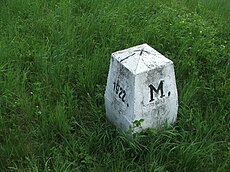|
Hungary–Romania border
 The Hungary–Romania border (Hungarian: magyar–román államhatár; Romanian: Frontiera între Ungaria și România) is the state border between Hungary and Romania. It was established in 1920 by an international commission (the "Lord Commission") presided over by geographers including Emmanuel de Martonne and Robert Ficheux,[1] and historians Robert William Seton-Watson and Ernest Denis.[2] The border was set by the Treaty of Trianon which was signed on 4 June 1920. The border is 448 km (278 mi) long, demarcated by pillars and approximately 20 km (12 mi) of the Mureș/Maros River. The border has been stable since the end of World War II, and is no longer officially in dispute between the countries.[3] The Hungary–Romania border is an internal border of the European Union and both countries are part of the Schengen Area. History Prior to World War I, the eastern and southern Carpathian Mountains formed a natural border between the Austro-Hungarian Empire and Romania.[4] Hungary and Romania became belligerents in World War I as Romania entered the war in 1916 on the side of the Allies. During that war the part of Transylvania south of the Maros (Mureș) and east of the Szamos (Someș) had been occupied by Romania forces at the time of the cease-fire agreement of Belgrade signed on 13 November 1918.[5] On 1 December 1918, the Great National Assembly of Alba Iulia declared union with the Kingdom of Romania. Subsequently, the Romanian forces moved further into Hungary and occupied Budapest from August to mid-November 1919.[6] The Treaty of Trianon finalized the armistice between the Allies and Hungary.[7] In the treaty Romania recovered all of Transylvania (including parts of Maramureș, Banat and Crișana),[8][9]  Briefly during World War II, Northern Transylvania (including part of Maramureș and Crișana) was returned to Hungary under the Second Vienna Award in 1940.[10][11] In 1944 as World War II drew to a close and Romania joined the war against Germany, the Allies agreed de facto to the Trianon boundaries, and this was confirmed at the Paris Peace Conference in 1946, and by the subsequent peace treaties formalized in 1947.[11][12] Geography  The Hungarian–Romanian border begins at a tripoint located in the historical region of the Banat, 15 km (9.3 mi) south-east of the Hungarian town of Szeged, where the border between Hungary and Serbia intersects the land border between Romania and Serbia. It generally runs south-south-westwards/north-north-eastwards across the Pannonian Basin to another tripoint located on the Tur river, 16 km (9.9 mi) north of the Romanian town of Satu Mare, where the Hungarian-Ukrainian border intersects the land border between Romania and Ukraine. Counties along the borderHungaryFour Hungarian Counties has borders with Romania. These are the follows: RomaniaFour Romanian Counties has borders with Hungary. These are the follows: Border crossingsRoad
RailAll railway crossings are standard gauge. As of June 2019, all railway crossings have passenger traffic.
See alsoReferencesWikimedia Commons has media related to Hungary-Romania border.
|
|||||||||||||||||||||||||||||||||||||||||||||||||||||||||||||||||||||||||||||||||||||||||||||||||||||||||||||||||||||||||||||||||||||||||||||||||||||||||||||||||||||||||||
